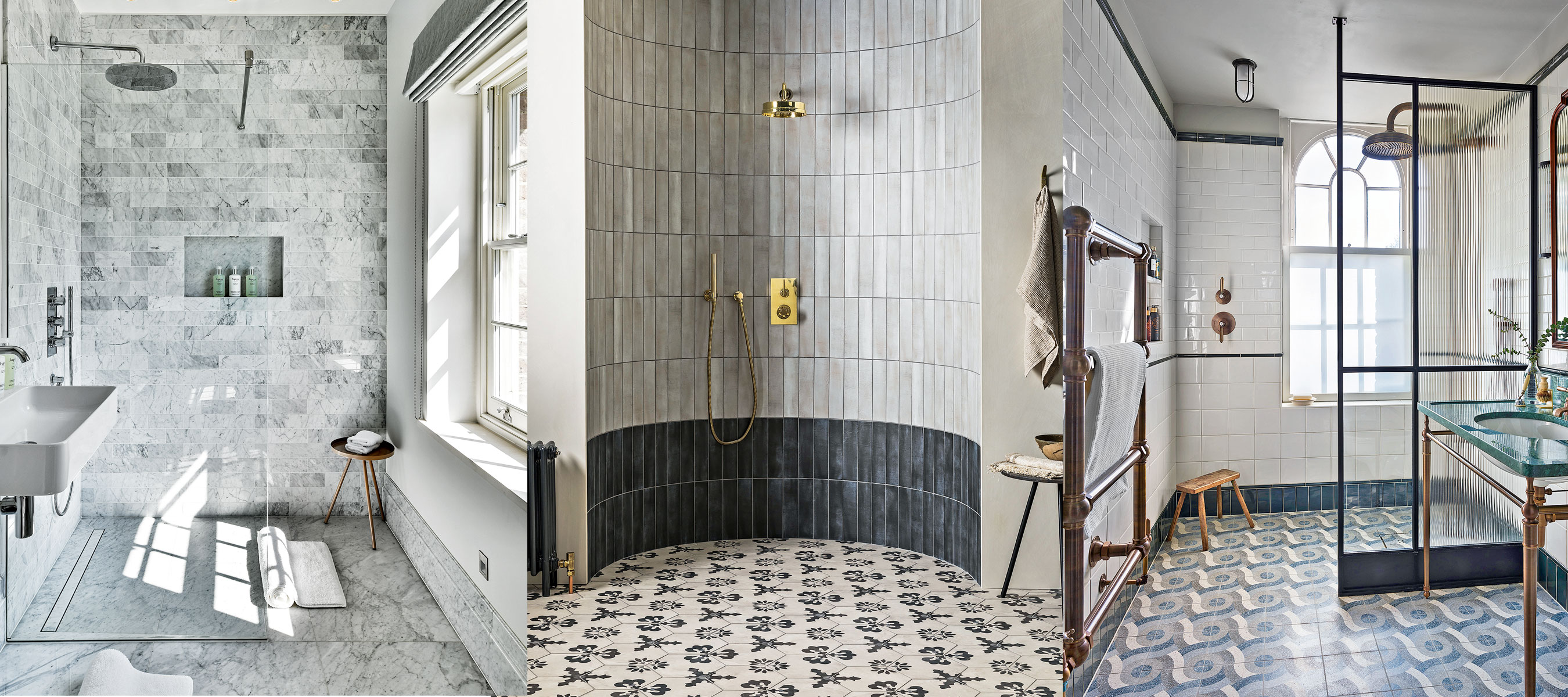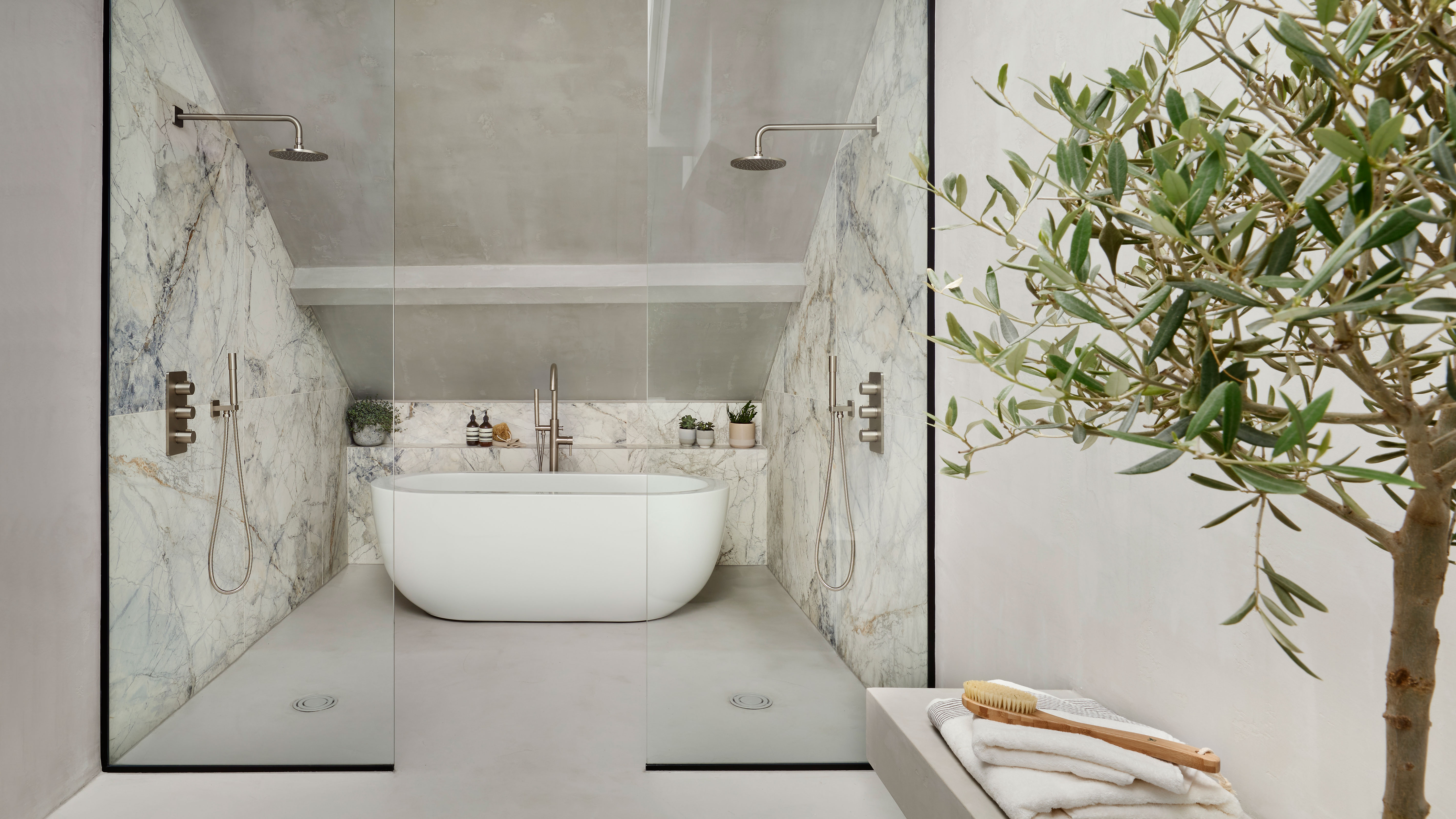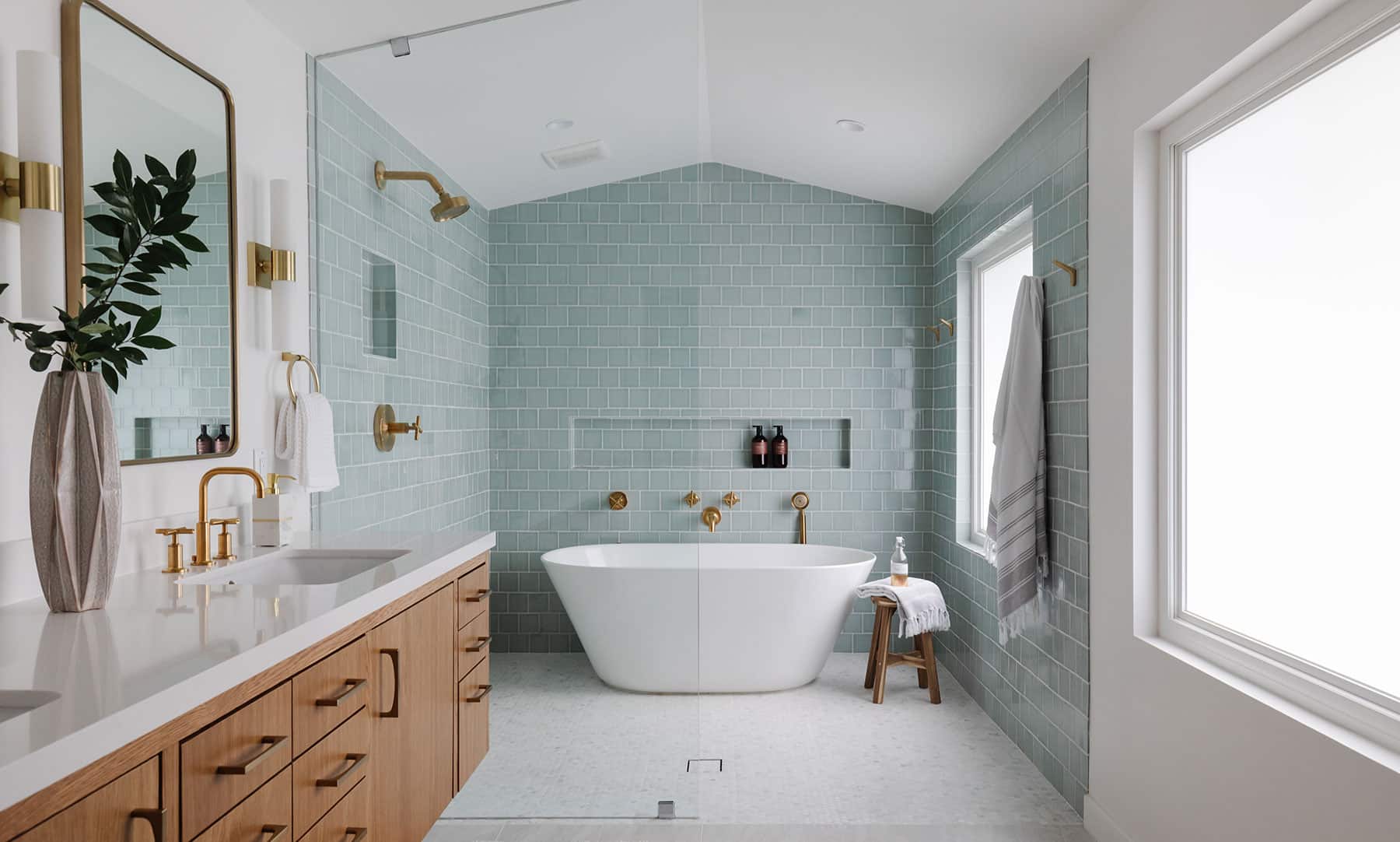Wet Room Basics: Wet Room Bathroom Ideas

A wet room bathroom is a contemporary design that eliminates the traditional shower stall or bathtub and creates a seamless, open space where the entire floor is waterproofed and sloped towards a central drain. This design offers a sleek, modern aesthetic and provides a more spacious and accessible showering experience.
Wet Room Features
Wet rooms are characterized by several key features that distinguish them from traditional bathrooms:
- Waterproof Flooring: Wet rooms require a waterproof membrane applied to the entire floor and walls to prevent water damage. This membrane can be made of various materials, including concrete, tile, or specialized waterproof coatings.
- Sloped Floor: The floor in a wet room is sloped towards a central drain, ensuring that water flows away from the showering area and prevents pooling. The slope should be gradual, typically around 1/4 inch per foot, to allow for comfortable walking.
- Showerhead Placement: Showerheads in wet rooms are often mounted on the ceiling or wall, creating a more immersive and luxurious showering experience.
- Waterproofing: Wet rooms require meticulous waterproofing, ensuring that all joints and seams are sealed to prevent water from penetrating the underlying structure. This involves using specialized waterproof sealants and membranes.
Advantages of Wet Rooms
Wet rooms offer numerous advantages over traditional bathrooms, making them a popular choice for modern homes:
- Spaciousness: The open design of a wet room creates a sense of spaciousness, especially in smaller bathrooms.
- Accessibility: Wet rooms are highly accessible for people with mobility issues, as they eliminate the need to step over a shower threshold.
- Modern Aesthetics: Wet rooms offer a sleek and modern aesthetic, creating a sophisticated and contemporary bathroom design.
- Flexibility: Wet rooms can be customized to fit any bathroom layout and design preferences, offering greater flexibility than traditional bathrooms.
Disadvantages of Wet Rooms
While wet rooms offer many advantages, they also have some drawbacks to consider:
- Cost: Wet room construction can be more expensive than traditional bathrooms, due to the specialized waterproofing and materials required.
- Complexity: Installing a wet room requires skilled labor and attention to detail to ensure proper waterproofing and drainage.
- Maintenance: Wet rooms require regular cleaning and maintenance to prevent mold and mildew growth.
- Potential for Water Damage: If the waterproofing is not properly installed or maintained, there is a risk of water damage to the surrounding structure.
Building Codes and Regulations
Building codes and regulations for wet rooms vary depending on the location and jurisdiction. However, some common requirements include:
- Waterproofing: Building codes typically specify the type and thickness of waterproofing membranes required for wet rooms.
- Drainage: Regulations often dictate the size and capacity of the drain required to handle the water flow from the wet room.
- Ventilation: Adequate ventilation is essential to prevent moisture buildup and mold growth in wet rooms. Building codes may specify ventilation requirements.
- Safety: Building codes often include safety requirements for wet rooms, such as non-slip flooring and grab bars.
Wet Room Design Inspiration

Transforming a bathroom into a wet room opens a world of design possibilities, allowing you to create a truly unique and personalized space. Wet rooms offer a seamless, minimalist aesthetic, while providing flexibility in layout and style. Let’s explore the diverse design options available, drawing inspiration from different styles and materials.
Wet Room Styles
Different styles cater to various preferences and create distinct atmospheres. Here are some popular wet room styles:
- Minimalist: This style prioritizes clean lines, simple shapes, and a neutral color palette. The focus is on functionality and a sense of openness. Minimalist wet rooms often feature large, uninterrupted tiles, sleek fixtures, and minimal décor.
- Contemporary: Characterized by modern elements, contemporary wet rooms incorporate geometric shapes, bold colors, and innovative materials. Think exposed concrete, metallic accents, and statement lighting.
- Traditional: This style embraces classic elegance and timeless design. Traditional wet rooms often feature ornate fixtures, natural stone, and warm color palettes.
- Industrial: This style combines raw materials like exposed brick, metal, and reclaimed wood to create a rugged and edgy aesthetic. Industrial wet rooms often feature exposed pipes, vintage lighting, and dark color palettes.
Materials and Finishes
The choice of materials significantly influences the overall look and feel of a wet room. Here are some popular options:
- Tiles: Tiles offer a wide range of colors, patterns, and textures, providing versatility in design. Large-format tiles create a seamless, minimalist look, while smaller tiles can add visual interest and pattern.
- Stone: Natural stone adds a touch of luxury and sophistication to a wet room. Marble, granite, and limestone are popular choices, offering a range of colors and textures.
- Concrete: Exposed concrete creates a raw and industrial aesthetic, adding a touch of urban chic. Polished concrete offers a smooth, sleek finish, while textured concrete adds visual interest.
- Glass: Glass is often used for shower screens and partitions, providing a sense of openness and allowing natural light to flow through the space.
Wet Room Layouts and Shower Configurations
The layout of a wet room is crucial for functionality and aesthetics. Consider these different shower configurations:
- Walk-in Showers: These showers offer easy access and a spacious feel. A curbless design creates a seamless transition from the floor to the shower area, eliminating barriers.
- Corner Showers: Corner showers are a space-saving option, making the most of a corner space. They can be designed with a single or multiple shower heads, offering flexibility in shower experience.
- Multi-head Showers: For a luxurious experience, consider a multi-head shower system. Multiple shower heads strategically placed throughout the shower area create a spa-like atmosphere and offer a variety of shower options.
Wet Room Features and Components

A wet room is a bathroom design where the entire floor area is waterproofed, allowing for a seamless transition between the shower and the rest of the bathroom space. This creates a modern, minimalist aesthetic and enhances accessibility for individuals with mobility challenges. However, the success of a wet room depends on carefully selecting and installing the right features and components.
Waterproofing and Drainage
Waterproofing is crucial for wet rooms to prevent water damage to the underlying structure. A comprehensive waterproofing system involves applying a waterproof membrane to the walls and floor, creating a barrier that prevents water from penetrating the substrate. The membrane is typically applied over a smooth, level surface, ensuring proper adhesion and preventing water from seeping through any cracks or gaps.
The drainage system is equally important, as it effectively removes water from the wet room floor, preventing water accumulation and potential hazards. Wet rooms often employ a linear drain, a long, narrow drain positioned along one or more walls. These drains are designed to collect water from a larger area, promoting efficient drainage. The linear drain is usually covered by a decorative grille, seamlessly blending into the floor design.
Wet Room Trays
Wet room trays are essential for creating a level, waterproof surface and facilitating proper drainage. They are typically made of materials like acrylic, fiberglass, or stone, each offering unique advantages.
Types of Wet Room Trays
- Pre-formed Trays: These are ready-made trays that come in various sizes and shapes, making installation straightforward. They often feature a pre-installed drain, simplifying the drainage system setup.
- Custom-made Trays: For unique bathroom designs or spaces with unusual dimensions, custom-made trays offer a bespoke solution. They are crafted to fit the exact specifications of the wet room, ensuring a perfect fit and a seamless integration into the overall design.
- Tiled Trays: These trays are created by building a waterproof layer directly onto the floor, followed by tiling. This method allows for greater design flexibility, as the tiles can be chosen to match the bathroom’s overall aesthetic.
Installation Process
- Preparation: The floor surface needs to be prepared for the tray installation. This involves leveling the floor and ensuring it is smooth and free of any debris or imperfections.
- Installation: The tray is then carefully positioned on the prepared floor, ensuring it is level and aligned. It is often secured to the floor using adhesive or mechanical fixings, depending on the tray type and manufacturer’s recommendations.
- Drainage Connection: The drain is connected to the tray and the waste pipe, ensuring a secure and watertight connection. This step requires careful attention to detail, as any leaks can lead to significant water damage.
- Finishing: The final step involves sealing the edges of the tray with a waterproof sealant, creating a barrier against water ingress. This helps prevent water from seeping under the tray and damaging the underlying structure.
Wet Room Components
A well-designed wet room incorporates various components that enhance its functionality and aesthetics.
Showerheads
- Overhead Showerheads: These are commonly used in wet rooms, offering a luxurious showering experience. They can be fixed or adjustable, allowing for customized water flow and spray patterns.
- Handheld Showerheads: These provide flexibility and versatility, allowing for easy cleaning and targeted showering. They are often attached to a slide bar, enabling height adjustment.
- Rain Showerheads: These large, flat showerheads mimic the sensation of a gentle rain shower, creating a spa-like atmosphere.
Faucets
- Wall-mounted Faucets: These are commonly used in wet rooms, as they provide a sleek and minimalist aesthetic. They are often integrated with thermostatic controls, ensuring a consistent water temperature.
- Deck-mounted Faucets: These are mounted on the wet room tray or countertop, offering a more traditional look. They are often used in conjunction with freestanding tubs or basins.
Drains
- Linear Drains: These are long, narrow drains positioned along one or more walls, offering a contemporary and efficient drainage solution. They are often concealed under a decorative grille, seamlessly blending into the floor design.
- Point Drains: These are traditional drains located in the center of the wet room floor. They are often less aesthetically pleasing than linear drains but offer a reliable and straightforward drainage solution.
Ventilation Systems
Proper ventilation is essential for preventing moisture buildup in the wet room, which can lead to mold and mildew growth.
- Exhaust Fans: These fans extract humid air from the wet room, preventing condensation and promoting a healthy environment. They are often activated by a humidity sensor, ensuring efficient operation.
- Window Ventilation: If the wet room has a window, opening it for regular ventilation can help control humidity levels. However, this option may not be suitable in all climates or locations.
Wet Room Lighting and Storage

Wet room bathroom ideas – A wet room’s lighting and storage are essential for creating a functional and visually appealing space. Properly illuminating the room can enhance its atmosphere and highlight its design features. Meanwhile, well-planned storage solutions help keep the space organized and clutter-free.
Lighting Plan, Wet room bathroom ideas
A comprehensive lighting plan should consider natural light, artificial light, and accent lighting to create a balanced and functional environment.
- Natural Light: Maximize natural light by using large windows or skylights. This creates a brighter and more inviting space, reducing the need for artificial light during the day.
- Artificial Light: Choose a combination of overhead lighting and task lighting to provide sufficient illumination for various activities. For example, recessed LED lights can provide general illumination, while vanity lights can be used for grooming tasks.
- Accent Lighting: Highlight architectural features, such as a shower niche or a decorative tile wall, with accent lighting. Use LED strip lights or spotlights to create visual interest and emphasize specific areas.
Storage Solutions
Smart storage solutions are crucial for maintaining a clean and organized wet room. Integrated shelves, cabinets, and niches can maximize storage space without compromising the room’s aesthetic appeal.
- Integrated Shelves: Recessed shelves within the shower area provide a convenient spot for storing toiletries and other shower essentials. Choose waterproof materials like glass or stainless steel for durability.
- Cabinets: Wall-mounted cabinets with waterproof finishes offer ample storage for towels, linens, and other bathroom items. Look for cabinets with pull-out drawers or shelves for easy access.
- Niches: Create a decorative and functional niche within the shower area to store shampoo bottles, soap dispensers, and other shower accessories. Niches can be built into the wall or incorporated into the shower enclosure.
Mirrors and Reflective Surfaces
Mirrors and other reflective surfaces can significantly enhance the perceived size and brightness of a wet room. Strategic placement of mirrors can create the illusion of more space and amplify the effects of natural and artificial lighting.
- Large Mirrors: A large mirror above the vanity can make the room appear more spacious and reflect light, creating a brighter atmosphere.
- Reflective Tiles: Using tiles with a high-gloss finish can create a similar effect to mirrors, reflecting light and adding a touch of elegance to the space.
- Metallic Accents: Incorporating metallic finishes, such as chrome or brushed nickel, on faucets, towel bars, and other fixtures can add a reflective element and enhance the overall design.
